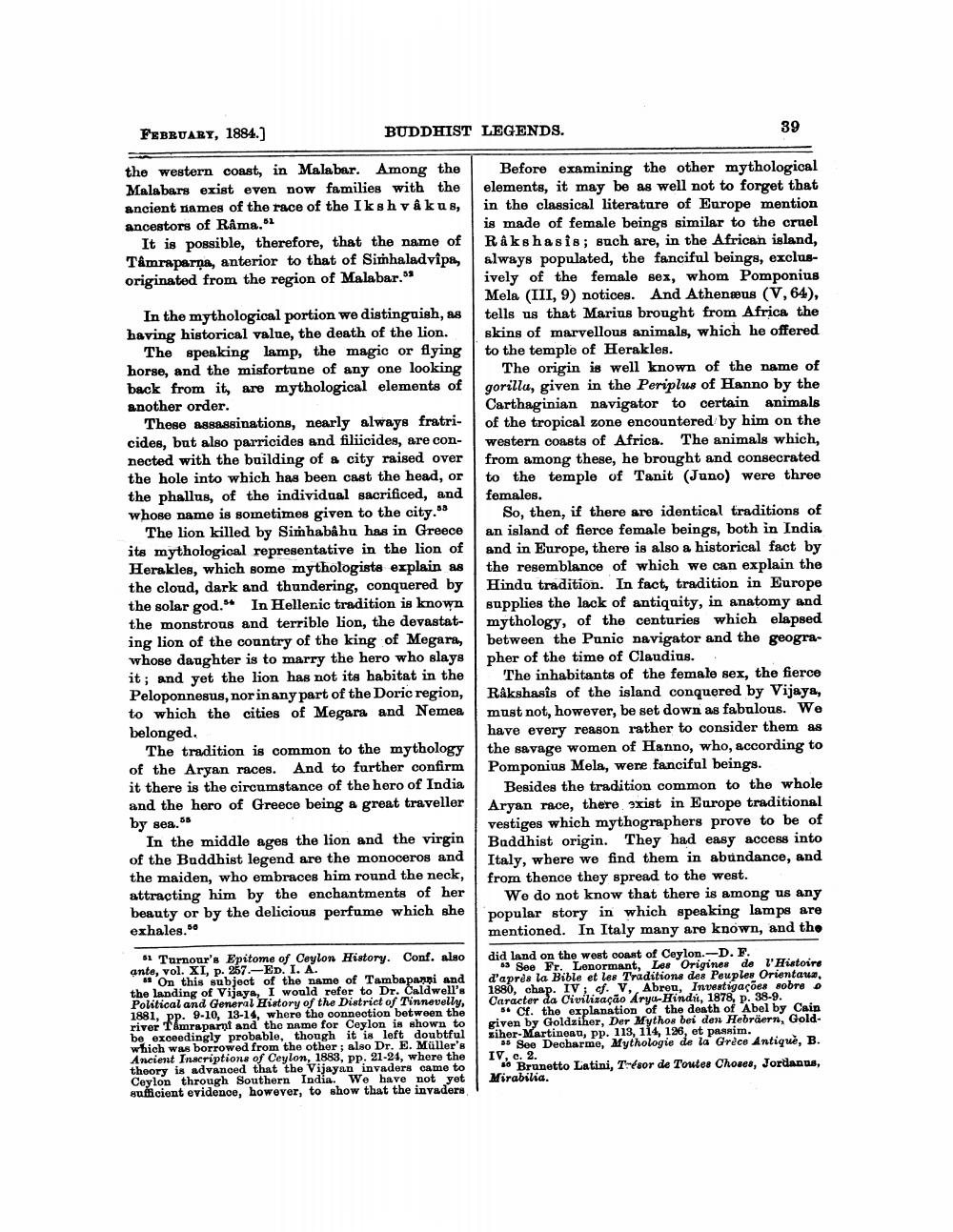________________
FEBRUARY, 1884.)
BUDDHIST LEGENDS.
39
the western coast, in Malabar. Among the Malabars exist even now families with the ancient names of the race of the Iksh vâkus, ancestors of Râma.
It is possible, therefore, that the name of Tamraparna, anterior to that of Simhaladvipa, originated from the region of Malabar."
In the mythological portion we distinguish, as having historical value, the death of the lion.
The speaking lamp, the magic or flying horse, and the misfortune of any one looking back from it, are mythological elements of another order.
These assassinations, nearly always fratri- cides, but also parricides and filiicides, are con- nected with the building of a city raised over the hole into which has been cast the head, or the phallus, of the individual sacrificed, and whose name is sometimes given to the city."
The lion killed by Simhabahu has in Greece its mythological representative in the lion of Herakles, which some mythologists explain as the cloud, dark and thundering, conquered by the solar god." In Hellenic tradition is known the monstrous and terrible lion, the devastating lion of the country of the king of Megara, whose daughter is to marry the hero who slays it; and yet the lion has not its habitat in the Peloponnesus, norin any part of the Doric region, to which the cities of Megara and Nemea belonged.
The tradition is common to the mythology of the Aryan races. And to further confirm it there is the circumstance of the hero of India and the hero of Greece being a great traveller by sea."
In the middle ages the lion and the virgin of the Buddhist legend are the monoceros and the maiden, who embraces him round the neck, attracting him by the enchantments of her beauty or by the delicious perfume which she exhales.
Before examining the other mythological elements, it may be as well not to forget that in the classical literature of Europe mention is made of female beings similar to the cruel Rakshasis; such are, in the African island, always populated, the fanciful beings, exclusively of the female sex, whom Pomponius Mela (III, 9) notices. And Athenæus (V, 64), tells us that Marius brought from Africa the skins of marvellous animals, which he offered to the temple of Herakles.
The origin is well known of the name of gorillu, given in the Periplus of Hanno by the Carthaginian navigator to certain animals of the tropical zone encountered by him on the western coasts of Africa. The animals which, from among these, he brought and consecrated to the temple of Tanit (Juno) were three females.
So, then, if there are identical traditions of an island of fierce female beings, both in India and in Europe, there is also a historical fact by the resemblance of which we can explain the Hindu tradition. In fact, tradition in Europe supplies the lack of antiquity, in anatomy and mythology, of the centuries which elapsed between the Punic navigator and the geographer of the time of Claudius..
The inhabitants of the female sex, the fierce Rakshasis of the island conquered by Vijaya, must not, however, be set down as fabulous. We have every reason rather to consider them as the savage women of Hanno, who, according to Pomponius Mela, were fanciful beings.
Besides the tradition common to the whole Aryan race, there exist in Europe traditional vestiges which mythographers prove to be of Baddhist origin. They had easy access into Italy, where we find them in abundance, and from thence they spread to the west.
We do not know that there is among us any popular story in which speaking lamps are mentioned. In Italy many are known, and the did land on the west coast of Ceylon.-D. F.
* See Fr. Lenormant, Los Origines de l'Histoire d'après la Bible et les Traditions des Peuples Orientau 1880, chap. IV; cf. v,, Abrou, Investigações sobre o Caracter da Civilização Aryu-Hindit, 1878, p. 38-9.
5. Cf. the explanation of the death of Abel by Cain given by Goldziher, Der Mythos bei den Hebräern, Goldziher-Martineau, pp. 113, 114, 126, et passim. * See Decharme, Mythologie de la Grèce Antique, B.
Brunetto Latini, Trésor de Toutes Choses, Jordanus, Mirabilia.
Turnour's Epitome of Ceylon History. Conf. also ante, vol. XI, p. 257.-ED. I. A.
** On this subject of the name of Tambapanni and the landing of Vijaya, I would refer to Dr. Caldwell's Political and General History of the District of Tinnevelly, 1881, pp. 9-10, 13-14, where the connection between the river Tamraparnt and the name for Ceylon is shown to be exceedingly probable, though it is left doubtful which was borrowed from the other; also Dr. E. Muller's Ancient Inscriptions of Ceylon, 1883, pp. 21-24, where the theory is advanced that the Vijayan invaders came to Ceylon through Southern India. We have not yet suficient evidence, however, to show that the invaders
IV. 2.




